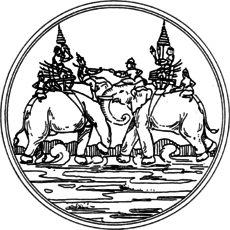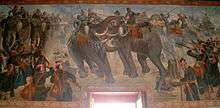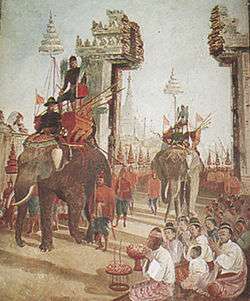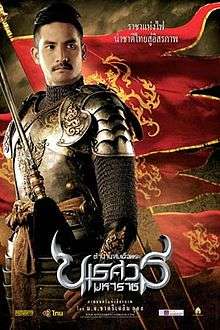Naresuan
| Naresuan นเรศวร | |
|---|---|
|
King of the Ayutthaya Kingdom Emperor of Lan Na | |
 Statue of King Naresuan pouring water on the ground, symbolizing declaration of independence from Tongauo Empire, Hongsawadi and annex Suphannaphum Dynasty into Sukhothai Dynasty cause Personal union status for 145 years, at Naresuan University, Phitsanulok province, Thailand[1] | |
| King of Siam | |
| Reign | 29 July 1590 – 25 April 1605 |
| Predecessor | Mahathammarachathirat |
| Successor | Ekathotsarot |
| Emperor of Lan Na | |
| Reign | c. 1602 – 25 April 1605 |
| Predecessor | Nanda |
| Successor | Ekathotsarot |
| King | Nawrahta Minsaw |
| Born |
1555 Chan Palace, Phitsanulok, Sukhothai Kingdom |
| Died | 25 April 1605 (aged 49) |
| Spouse | Chao Khrua Manichan |
| House | Sukhothai Dynasty |
| Father | Mahathammarachathirat |
| Mother | Wisutkasat |
Naresuan (Thai: นเรศวร, Khmer: នរេឝ្វរៈ or នរេសូរ) or Sanphet II (Thai: สรรเพชญ์ที่ 2 or Khmer: សព៌េជ្ញទី២, 25 April 1555 –1605) was the King of the Ayutthaya Kingdom from 1590 and Emperor of Lan Na Kingdom from 1602 until his death in 1605. Naresuan is one of Thailand's most revered monarchs as he was known for his campaigns to free Ayutthaya from the Bamars under the Taungoo Dynasty. During his reign, numerous wars were fought against Taungoo Burma. Naresuan also welcomed the Dutch.[2]:242
Early life
Prince Naret was born in the city of Phitsanulok on 25 April 1555. He was the son of King Mahathammarachathirat of Phitsanulok and his queen consort, Wisutkasat. His mother was a daughter of Maha Chakkraphat and queen consort Suriyothai. His father was a Sukhothai noble who had defeated Worawongsathirat in 1548 and put Maha Chakkraphat on the throne. Prince Naret, also known as the "Black Prince" (Thai: พระองค์ดำ), had a younger brother Ekathotsarot, known as the "White Prince", and an elder sister, Suphankanlaya.[2]:67
In the second siege of Ayutthaya (1563–64), King Bayinnaung of the Taungoo Dynasty of Bago, Burma (formerly known in Burmese as Hanthawaddy (Burmese: ဟံသာဝတီ and in Thai as rtgs: Hongsawadi หงสาวดี) led massive armies, invading the country and laying siege to Phitsanulok. Maha Thammarachathirat came to believe that the city would not be able to withstand a long siege due to a scarcity of food and a smallpox outbreak, so he surrendered the city. King Bayinnaung took Phitsanulok and made the Sukhothai Kingdom a Burmese tributary state; and required Maha Thammarachathirat to send his son—the Black Prince—to Bago as a hostage to ensure the king's fidelity.[2]:36,67
At Bago
In the third siege of Ayutthaya (1568–1570), Bayinnaung was able to conquer the kingdom and installed Maha Thammarachathirat as a vassal king. After six years of captivity, Prince Naret and his brother the White Prince were released to Ayutthaya, in exchange for their sister Suphankanlaya becoming Bayinnaung's secondary wife in 1571.[2]:63,67,75
While in Burma, "he followed the best of Burmese military training," studying alongside the "elite of Burmese youth, sons of princes and nobles." "Besides being gifted in military prowess, Naresuan who was highly intelligent, gained a great deal of general knowledge of the times."[3]:43
Viceroy
| Phitsanulok History This box contains links to selected |
| Prehistoric Era |
|---|
| Khmer Empire |
| Singhanavati City-State |
| Sukhothai Period |
|
Wat Chula Manee · Wat Aranyik |
| Ayutthaya Period |
|
Borommatrailokkanat |
| Modern Siam / Thailand |

Maha Thammarachathirat made Naret the Uparaja ("viceroy") of Phitsanulok as Naresuan at the age of sixteen.[2]:67–68,75
Naresuan joined his father and the King of Bago in an expedition to conquer Vientiane, the capital of the restored Lan Xang, but he contracted smallpox and had to return. He built Chankasem Palace in Ayutthaya as a residence when he visited his parents.[2]:77
In 1581, Bayinnaung died, and was succeeded by his son Nanda Bayin. The viceroy of Inwa then rebelled, forcing Nanda Bayin to call upon the viceroys of Prome, Taungoo, Chiang Mai, Vientiane, and Ayutthaya for assistance in suppressing the rebellion. Naresuan marched the Siamese armies to Bago as ordered, but was slow in arriving. This raised Nanda Bayin's suspicions, who ordered his son, the Maha Uparaja Mingyi Swa, to remain in the capital and kill Naresuan.[2]:79, 83–84
Naresuan reached Kraeng in June 1583, where he learned that Phraya Ram and Phraya Kiet had been sent by the Maha Uparat to attack Naresuan from the rear while Maha Uparat attacked from the front. Naresuan called a council, which included priests, Phraya Kiat, Phraya Ram, and other Mons. Naresuan then "poured water on the earth from a gold goblet to proclaim to the devatas in the presence of the persons assembled, that from that day forth Siam had severed friendship with Hongsawadi and was no longer in amity as of yore."[2]:85–86
Naresuan then levied the Mons to join his campaign and marched onto Bago, intending to free the Siamese families held captive there. However, Nanda Bayin had already defeated the viceroy of Innwa and was returning to his capital. Naresuan then retreated after freeing about 10,000 families. Mingyi Swa pursued with Surakamma in the advance element. The Burmese caught up with the Siamese at the Satong River. There Surakamma was killed by "the royal gun used by Somdet Phra Naresuan while crossing the Satong river". This sent the Maha Uparat's troops into a panicked retreat, prompting him to return to the capital.[2]:87–88
Naresuan then held the "ceremony of swearing allegiance" with the people of Sukhothai, drinking water from the sacred pond of Puay Si. His forces then took Sawankhalok. In 1584 Naresuan brought down all of the men from the northern provinces to the Siamese capital of Ayutthaya in preparation for the attack of the Bago army.[2]:92–93
In the same year Nanda Bayin sent two separate armies, one under his uncle the viceroy of Pathein, and another from Chiang Mai under his younger brother Noratra Mangsosri. Both were defeated in separate engagements before they could unite, and were driven back in retreat.[2]:94–98 Then in 1585, Naresuan defeated the Viceory of Chiang Mai near Pa Mok and Bang Kaeo, capturing his encampment at Ban Saket with 10,000 soldiers, 120 elephants, 100 horses, 400 boats plus arms, ammunition, and provisions.[2]:99–107
In 1586, Nanda Bayin himself led the Burmese armies to Ayutthaya and begin the fourth siege of Ayutthaya. Nanda Bayin armies laid siege to the city for five months, but failed to take the city due to an aggressive defense by Naresuan. He retreated.[2]:108–115
In 1590, Maha Thammarachathirat died and Naresuan was crowned King of Ayutthaya as Sanphet II. The Burmese army led by Phra Maha Uparat attacked Siam again, but Naresuan defeated it near Ban Khoi. The Burmese army retreated back to Bago, losing many men, elephants, horses, arms, and ammunition.[2]:116–119
Reign as King of Ayutthaya
The elephant battle

In 1592, Nanda Bayin ordered his son to attack Ayutthaya again. Mingyi Swa, Natshinnaung the son of the viceroy of Taungoo, and the viceroy of Prome formed three divisions. Mingyi Swa went through Three Pagodas Pass while the other two divisions came via Mae Lamao. The chief of Chiang Mai sent a boat force. Naresuan had been planning to attack Cambodia because of its border incursions, but then adjusted to the Burmese threat. Naresuan marched towards Suphan Buri and encamped his armies at Nong Sarai near the Thakhoi River. Naresuan formed a battle plan which involved a retreat, allowing the Burmese to follow, and then attack the disordered advance with his main army.[2]:12–130
During the battle, the war elephants of Naresuan, Chaophraya Chaiyanuphap, and Ekathotsarot, Chaophraya Prap Traichak, were "in musth" and charged into the midst of the Burmese, with only a handful to Siamese being able to follow them in. Naresuan, seeing Mingyi Swa on an elephant under a tree, shouted, "My brother, why do you stay on your elephant under the shade of a tree? Why not come out and engage in single combat to be an honour to us? There will be no kings in future who will engage in single combat like us."[2]:130–131[4]

The personal battle between Naresuan and Mingyi Swa was a highly romanticized historical scene known as the "Elephant Battle" (สงครามยุทธหัตถี Songkram Yuddhahatthi.[5])
After a prolonged duel and narrowly missing Naresuan but cutting his helmet, Naresuan was able to cut Mingyi Swa with his ngaw (glaive) . Prince Somdet Phra Ekathotsarot was also able to kill the governor of Muang Chacharo. The main Siamese army then arrived and the Burmese were routed and scattered. The King of Bago then ordered the other two divisions to retreat.[2]:131–133
Naresuan's ngaw, Chao Phraya Prap Hongsawadi or "Chao Phraya which defeated Bago", and helmet, Chao Phraya Sen Phonlaphai or "Chao Phraya which defeated a hundred thousand soldiers", still exist today. Naresuan built a pagoda on the site of the elephant battle as a victory monument.[2]:134
Naresuan brought before a council of judges those commanders he thought had disobeyed him or were negligent in their duties; they had been unable to follow him into the middle of the Burmese. The punishment was death. However, Somdet Phra Phanarat, a bhikkhu from Wat Yai Chai Mongkhon, calmed Naresuan enough to have the punishment rescinded. Instead, the guilty commanders were ordered to take Dawei and Tanintharyi for redemption.[2]:136–138

Dawei and Tanintharyi
In 1592, Naresuan sent Chao Phraya Chakri and Phraya Phra Khlang to attack Tanintharyi and Dawei, a Mon city, which fell after 15- and 20-day sieges respectfully. Nanda Bayin launched a Burmese fleet to defend those cities, but arrived too late and was defeated by a combined Thai fleet. Additionally, a land force marching from Mottama was ambushed by the combined Chakri and Khlang force, resulting in the capture of 11 Burmese commanders, many elephants, horses, men, arms, and ammunition.[2]:138–143
Capture of Longvek
In 1593, Naresuan then launched a successful campaign to subjugate Cambodia, and executed its king Nakphra Sattha or Chey Chettha. Naresuan then brought Khmer families to populate his northern provinces.[2]:143–144
Capture of Mottama
As Burmese control over the tributaries had weakened, the Mons took this opportunity to free themselves. The Mon governor of Mawlamyine rebelled against Bago and requested Siamese support. Naresuan sent troops to help and the Burmese abandoned their garrison at Martaban. Nanda Bayin then sent the viceroy of Taungoo to suppress the uprising, but his force was defeated. The Mon provinces then became subject to the Siamese Kingdom.[2]:145–147[6]
Invasion of Bago

Naresuan then decided to attack Bago in 1595. He laid siege on the city for three months before retreating when the viceroys of Prome, Taungoo, and Ava sent relief forces. Naresuan did take back many prisoners of war, lessening the fighting strength of the Burmese.[2]:148–150
The Lord of Prome staged a rebellion against Nanda Bayin in 1595, followed by Taungoo, Rakhine, Lanna, and Lan Xang. King Nokeo Koumane of Lan Xang prepared to march through Lan Na to Bago to rescue the people of Lan Xang held captive. The Viceroy of Lan Na Chiang Mai then submitted his territory to Siamese control and Naresuan sent Siamese forces to prevent Laotian forces from entering Lanna.[2]:151–155
After these series of upheavals in the Burmese Empire, Naresuan decided to attack Bago again in 1599, using Arakan and Taungoo as allies. However, before Naresuan arrived at the city, the forces of Arakan and Taungoo had already invested the city. The Viceroy of Taungoo ended up taking the populace back to Taungoo, abandoning the city to the forces of Arakan to loot what property was left behind, and then setting flames to the palace and monasteries.[2]:156–162
Invasion of Taungoo and Lan Na
Naresuan occupied Bago while Minye Thihathu II, Viceroy of Taungoo, had already taken Nanda Bayin to Taungoo. Naresuan requested Minye Thihathu send Nanda Bayin back to him but Minye Thihathu refused, stating he was unwell. After that Naresuan laid siege to Taungoo for two months but retreated due to lack of food.[2]:162–166
Death
Natshinnaung killed Nanda Bayin while he was held captive in Toungoo. Nyaungyan Min then crowned himself as the King of Ava to counter the Viceroys of Toungoo and Prome. Siam was then free of a Burmese threat for four years until the King of Ava went on a campaign to subjugate the Shans. When he advanced as far as Theinni, Naresuan raised an army of 200,000 men to counter the threat to his kingdom. He advanced as far as the Fang District of Chiang Mai Province before falling ill and then died after three days. His brother King Ekathotsarot became his successor as king.[2]:173–180
Recent studies of Burmese records by historians of Silpakorn University showed that he returned to Wiang Haeng, where he died of disease, probably smallpox.
Many Shan believe King Naresuan was cremated and his ashes interred in a stupa in Mongton, in the Daen Lao Range, in the southern part of the Shan State.[7]
Legacy

According to Damrong Rajanubhab, "Naresuan was recorded as a brave and glorious king. Therefore his glory is evident up to the present day. The kingdom of Siam at that period was widest in extent, opulent and redounding in glory."[2]:178
- Thai baht banknotes

- Royal Thai Armed Forces Day, 18 January, commemorates victory.
- HTMS Naresuan, Royal Thai Navy frigate.
- Naresuan University in Phitsanulok is named after the king and features a large statue of the king.
- One of the two largest dams in Phitsanulok Province is named the Naresuan Dam. It controls water flow of the Nan River north of the city of Phitsanulok.
- King Naresuan has been incorrectly attributed to winning his freedom through kickboxing matches with Burmese fighters, a feat actually accredited to Nai Khanom Tom.
- Following the 2014 Thai coup d'état, a free showing of a King Naresun movie was credited with making viewers feel happy.[9]
In media
- King Naresuan — a 2007 film series based on the king's life
- Khan Kluay — a 2006 animated Thai film based on the life of the king's war elephant, followed by the lives of the elephant's offspring in Khan Kluay 2.
- King Naresuan Online — a fantasy massively multiplayer online role-playing game (MMORPG) released in 2010 by KNO - King Naresuan Online
- Civilization V — PC game released in 2010 in which Siam has a unique unit named "Naresuan's Elephant" in honor of the king's elephant armies
| Naresuan Born: 1555 Died: 25 April 1605 | ||
| Regnal titles | ||
|---|---|---|
| Preceded by Maha Thammarachathirat |
King of Ayutthaya 29 July 1590–25 April 1605 |
Succeeded by Ekathotsarot |
| Preceded by Maha Thammarachathirat |
King of Sukhothai 1569–1583 |
Succeeded by Kingdom annexed |
References
- 1 2 Wararat (January 18, 2012). "50 Baht series 16". History and Series of Banknotes. Bank of Thailand. Retrieved August 24, 2013.
Back. The images of the statue of King Naresuan: Pouring water on the ground, symbolizing the declaration of independence, King Naresuan with his sword leading his troops to beat the Burmese camp, the statue of King Naresuan at the Don Chedi Memorial compound, Phra Chedi Chai Mongkol located at Wat Yai Chai Mongkol, Phra Nakhon Si Ayutthaya Province
- 1 2 3 4 5 6 7 8 9 10 11 12 13 14 15 16 17 18 19 20 21 22 23 24 25 26 27 28 Rajanubhab, D., 2001, Our Wars With the Burmese, Bangkok: White Lotus Co. Ltd., ISBN 9747534584
- ↑ Chakrabongse, C., 1960, Lords of Life, London: Alvin Redman Limited
- ↑ Treepet Metkarunchit. การประกาศอิสรภาพ [Declaration of Independence] (in Thai). Archived from the original on 18 May 2007. Retrieved August 24, 2013.
- ↑ Glenn S., ed. (August 24, 2013). "ยุทธหัตถี" (Dictionary). Royal Institute Dictionary-1982. Thai-language.com. Retrieved 2013-08-24.
a war elephant; combat while mounted on war elephants
- ↑ ราชการสงครามในสมเด็จพระนเรศวรมหาราช
- ↑ The Nation, Warrior king remains a very modern mystery, 30 April 2006
- ↑ Wararat (April 6, 1978). "Series 12". History and Series of Banknotes. Bank of Thailand. Retrieved August 24, 2013.
100 Baht. Back. The monument of King Naresuan the Great, Don Chedi Memorial, in Suphanburi
- ↑ Online Reporters (17 Jun 2014). "Thais cheered up by Naresuan movie". Bangkok Post. Retrieved 25 June 2014.
Most people who went to the see the free showing of the film 'The Legend of King Naresuan 5' arranged by the NCPO came away feeling happy, according to a survey by Abac Poll.
Additional reading
| Wikimedia Commons has media related to Naresuan. |
- Fernquist, Jon (Spring 2005). Mae Fah Luang University, ed. "The Flight of Lao War Captives from Burma back to Laos in 1596: A Comparison of Historical Sources" (PDF). SOAS Bulletin of Burma Research. University of London: School of Oriental and African Studies. 3 (1). ISSN 1479-8484. Retrieved August 24, 2013.
In 1596, one thousand Lao war captives fled from Bago, the capital of the kingdom of Burma, back to their native kingdom of Lan Sang. This incident is insignificant when compared to more cataclysmic changes like the founding or fall of dynasties, but it has attracted the attention of Western, Thai, and Burmese historians since the 17th century.
- Sunait Chutintaranond (1992). "The Image of the Burmese Enemy in Thai Perceptions and Historical Writings" (PDF). Journal of the Siam Society. Siam Heritage Trust. JSS Vol. 80.1.1l (digital). Retrieved August 24, 2013.
The image of the Burmese as an archenemy of the Thai gradually emerged in Thai historiography and literary works after the kingdom of Ayudhya fell to the Burmese armies in 1767. Prior to that tragic incident, Thai chroniclers were not anxious to record any historical event concerning the wars between Siam and Burma. The Luang Prasert Chronicle of Ayudhya (1680), for instance, does not specifically glorify the most famous victory of King Naresuan in the fight on elephantback with the Burmese crown prince, the Maha Uparacha, in 1592.
- Peter Borschberg (2014). The Memoirs and Memorials of Jacques de Coutre. Security, Trade and Society in 16th and 17th Century Southeast Asia (book). NUS Press. Retrieved August 30, 2015.